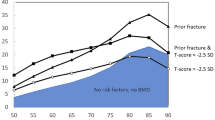Abstract:
As many as 40% of hip fractures occur in institutions for the elderly. Several studies have demonstrated a higher age-adjusted incidence of hip fractures in urban areas compared with rural areas. To assess whether this difference could be due to a preferential location of institutions for the elderly in urban areas, we compared the incidence of hip fractures over a 5-year period in urban versus rural areas, as defined according to the population density (urban >15 inhabitants/ha2). We then determined the age-adjusted incidence of hip fractures in institutional-dwelling elderly and home-dwelling elderly. Hip fracture incidence was 100.0/100 000 (150.5 in women and 43.8 in men) in urban areas, and 71.0/100 000 (107.2 in women and 32.8 in men) in rural areas (p<0.001). When only those patients living in their own homes were analyzed, the incidence was 66.7/100 000 (94.6 in women and 35.7 in men) in urban regions and 36.8/100 000 (49.6 in women and 23.4 in men) in rural areas (p<0.001), a difference of even greater magnitude than when both home-dwelling and institutional-dwelling residents were considered together. In a logistic regression model including age class, gender, urban or rural areas and institutionalization for inhabitants 65 years of age and older, urban residents have a 31% significantly (p<0.001) higher incidence of hip fracture compared with rural residents; women have a 79% significantly (p<0.001) higher incidence of hip fracture compared with men; and institutional-dwelling elderly have a 351% significantly (p<0.001) higher incidence of hip fracture compared with home-dwelling elderly. These results confirm the existence of a higher age-adjusted incidence of hip fractures in urban compared with rural areas. Since this difference is increased when patients living at home were analyzed separately, it indicates that the difference between urban and rural areas is not due to a preferential urban location of institutions for the elderly.
Similar content being viewed by others
Author information
Authors and Affiliations
Additional information
Received: 7 November 2000 / Accepted: 9 July 2001
Rights and permissions
About this article
Cite this article
Chevalley*, T., Chevalley*, T., Herrmann*, F. et al. Evaluation of the Age-Adjusted Incidence of Hip Fractures Between Urban and Rural Areas: The Difference Is Not Related to the Prevalence of Institutions for the Elderly . Osteoporos Int 13, 113–118 (2002). https://doi.org/10.1007/s001980200002
Issue Date:
DOI: https://doi.org/10.1007/s001980200002




